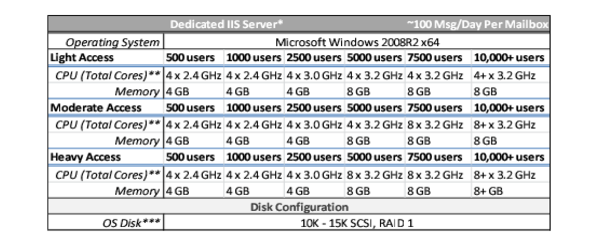Services server
|
• |
CPU (Total Cores)*: The total amount of required CPU cores increases as the number of active threads increases. The store management service will export a single mailbox in a single thread. More active threads allow a faster ingestion rate. Full Text Index also has the ability to run multiple processing threads. The administrator needs to find the appropriate balance. |
|
• |
Memory**: The total amount of required operating memory may be lower during initial archiving. As more data is archived and indexed, the memory footprint will increase. |
|
• |
Index Disk(s)***: The performance of the index disk will greatly impact the general performance of the product. For best results, use dedicated attached storage. New indexing technology allows the ability to span the index across multiple disk for both performance and fault tolerance. |
|
• |
Attachment Disk****: The performance of the attachment disk has less impact on the general performance of the product, but for the fastest retrievals, a faster disk is recommended. |
Dedicated IIS server
|
• |
Dedicated IIS Server*: The IIS Server can host multiple instances of the Archive Manager website. The website also supports Network Load Balancing (NLB) with IP-based affinity. Multiple web servers can be configured to host multiple Archive Manager website instances. |
|
• |
CPU (Total Cores)**: Total cores required will vary based on message policies. If stubbing is used, consider your environment moderate access or heavy access and plan accordingly. |
|
• |
OS Disk***: The OS disk will store attachments temporarily while users are downloading them. Disk speeds are typically not a bottleneck. |
Sizing the Microsoft SQL database and Archive Manager attachment store
|
IMPORTANT: For best performance, it is recommended that the full-text index files not reside on the same physical disk as other Archive Manager data repositories—neither the SQL database nor an attachment store. |
Pre-installation preparations
Each of these steps is explained in detail in the sections below.


